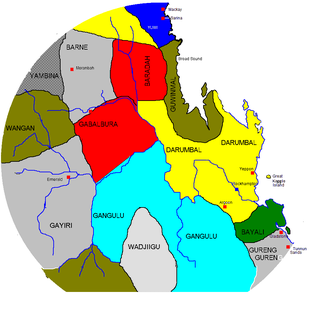
Ballardong are an indigenous Noongar people of the south western area of Western Australia.

Ballardong are an indigenous Noongar people of the south western area of Western Australia.
The Ballardong's land encompasses an estimated 10,500 square miles (27,000 km2). Northwards they occupy the Avon River. From the east of York they extend to Tammin, Kununoppin, Waddouring Hill, Bencubbin, Toodyay, Goomalling, and the Wongan Hills. On their southern flank lies Pingelly and Wickepin. Their western frontier is at the Darling Scarp. [1]
The Ballardong engaged in mining, quarrying stones to be shaped and sharpened for knives and multibarbed spears at Kalannie.
Source: Hackett 1886 , p. 344
The Bakanambia, also known as the Wanbara, are an Aboriginal group of Australia. Traditionally, the Bakanambia lived in the vicinity of Princess Charlotte Bay in the state of Queensland. One of the ethnonyms applied to them was Lama Lama, which is now used of a larger aggregation of remnants of several tribes.
Gkuthaarn, also rendered Kuthant, Kutanda and other variant spellings, is an extinct Paman language of the Cape York Peninsula, Queensland, Australia. It also known as Karundi/Garandi, but the Garandi language may be a separate dialect.
The Njakinjaki are an indigenous Noongar people of southern Western Australia, in the Wheatbelt and Great Southern regions.
The Kaneang are an indigenous Noongar people of the south west region of Western Australia.

Wiilman are an indigenous Noongar people from the Wheatbelt, Great Southern and South West regions of Western Australia. Variant spellings of the name include Wilman, Wirlomin, Wilmen and Wheelman. Wiilman is the endonym.
The Bibulman (Pibelmen) are an Aboriginal Australian people of the southwestern region of Western Australia, a subgroup of the Noongar.
The Kuungkari are an indigenous Australian people of Queensland. They are to be distinguished from the Kunggari.
The Maia were an indigenous Australian tribe of Western Australia.
The Yingkarta or Yingarda people, also written Inggarda and Ingarda, are an Aboriginal Australian people of the Gascoyne region of Western Australia.
The Nhanda people, also spelt Nanda, Nhunda, Nhanta, and other variants, are an Aboriginal Australian people who live in the Mid West region of Western Australia around the mouth of the Murchison River.
The Kuyani people, also written Guyani and other variants, and also known as the Nganitjidi, are an Aboriginal Australian people of the state of South Australia who speak the Kuyani language. Their traditional lands are to the west of the Flinders Ranges.
The Pilatapa were an Indigenous people of South Australia, now extinct.
The Bidjara people, also spelt Bitjara or Bithara, are an Aboriginal Australian people of south-western Queensland. They spoke a dialect of the Ngura language. They are not to be confused with the Warrego River Pitjara or the Badjiri of the Paroo River, both of whose traditional lands are further to the east of the state.
The Ringaringa (Ringu-Ringu) were an indigenous Australian people of the state of Queensland.
The Yanda were an indigenous Australian people of the state of Queensland.
The Rungarungawa were an Aboriginal Australian people of the state of Queensland.
The Yilba, also written Ilba and Jilba, are or were an Aboriginal Australian people of the present-day state of Queensland.
The Yagalingu are an Aboriginal Australian people of the state of Queensland. Their language may have been a dialect of Bidjara.

The Yambina were an Aboriginal Australian people of the state of Queensland, whose traditional lands lie inland (westwards) some distance from Mackay.
The Djankun are an Aboriginal Australian people of Far North Queensland.